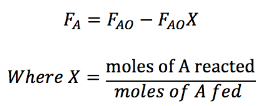
5.0 Reactor Design
5.1 Type of reactor being used
Anaerobic digestion systems have a variety of configurations, including the continuously stirred tank reactor (CSTR), plug flow (PF), and anaerobic sequencing batch reactor (ASBR) configurations. However, the CSTR is frequently used in research due to its simplicity in design and operation, plus for its advantages in experimentation. The CSTR provides greater uniformity of system parameters compared to other configurations, such as temperature, mixing, chemical concentration, and substrate concentration. Ultimately, when designing a full-scale reactor, the optimum reactor configuration will depend on the character of a given substrate among many other nontechnical considerations.
However, all configurations share fundamental design features and operating parameters that render the CSTR appropriate for most preliminary assessments.Lab-scale bioreactor configurations cannot be fed continuously due to plugging problems of lab-scale pumps with solids or settling of solids in tubing if researchers and engineers use an influent stream with relatively high concentrations of solids. For that scenario with continuous mixing requirements, lab-scale bioreactors are fed periodically and we refer to such configurations as continuously stirred anaerobic digesters (CSADs).
The advantages of this CSTR is the operation is continuous operation and good temperature control which is very suitable for this anaerobic digestion process as we will easy to find the specific temperature to maximise product of the process. It also easily adapts for two phase runs and good control of it. Simplicity of the construction reactor itself plus low operating (labour) cost make it perfect reactor to be chosen. Lastly it is easy to clean as the Interior of reactor is easily accessed.
5.2 Size of the reactor
The chemical equation of the reaction happening in the vessel is:
In the continuous stirred tank reactor (CSTR), reactants are fed to the reactor at the inlet and the products are removed from the reactor at the outlet.
In an ideal continuous stirred tank reactor, the reacting mixture is assumed to be well mixed and therefore the properties of the reacting mixture are uniformly distributed throughout the reactor. Furthermore, it is assumed that in an ideal continuous stirred tank reactor, the properties of the exit stream are the same as the properties of the reacting mixture within the reactor.
Reactor size of CSTR is obtained through the design equation for the reactant C6H12O6 (A) by writing the mass balance for reactant A over the entire volume of the reacting mixture V as follows:
Where :
FAo : is the number of moles of A per unit time entering the CSTR,
FA : is the number of moles of A per unit time leaving the CSTR,
MA : is the molar mass of A,
CA : is the molar concentration of A within the CSTR (which is assumed to be the same as the concentration of A at the exit)
−rA : is the molar rate at which A is disappearing because of the progression of the reaction.
Removing MA and rearranging it, to operate in an ideal CSTR at steady state hence we get the design equation for reactant Glucose (A) state as follows:
For continuous flow system, outlet flow rate equals to inlet flow rate reduced by molar flow rate at which A is consumed within the system.
By substitution,
Therefore, Size of the reactor used which is CSTR is as follow:
From the production decision,
Where 1 day = 24hours x 60 minutes x 60 seconds = 86400s
The rate of reaction can be written as follow:
Hence, -rA = 0.02878 x 39.6 = 1.14 mol/s.m3
Since we assume all the organic dry matter will be decomposed into biogas, the conversion rate = 1.
Therefore the reactor volume is
To determine the vessel diameter and height,
Where L = height, D = diameter.
Substitute equation 1 into 2,
When differential of total surface area equals to zero, we can determine minimum diameter of the reactor.
To determine height,
5.3 Operating Temperature and Pressure
5.4 Heating and cooling element
5.4 Cost of the reactor
In our plant, the reactor input is the food waste and therefore, the mass is 300kg per day.
The desired output is the methane gas and therefore, the mass produced is 102.67 per day.















We have chosen Mesophilic digestion as our primary reaction and therefore the temperature range of the operation will be 30-38°C.
Next, the operating pressure will be the atmospheric pressure because in Mesophilic digestion, mesophiles which are the primary microorganism present are in optimum condition for atmospheric pressure.
Yes, our operation needs the heating elements because the organic matter is required to be dry before entering the reactor.
Hence, in our plant a heat exchanger is installed for separation of dry organic matter and slurry. Besides the separation, sanitation of food waste can be done in heat exchanger since the temperature is efficient to kill some of the bacteria in the food waste.
Step counting methods are to estimate the capital cost of a proposed project. The technique is based on the premise that the capital cost is determined by a number of significant processing steps in the overall process.
Bridgwater, IChemE (1988), gives a developed relatively simple correlation for plant capacities under 60,000 tonne per year.

Our plant capacity is 300kg of food waste per day which is equivalent to 109500kg per year.
Therefore, equation 1 can be applied.
where C = capital cost in pounds sterling
N = Number of functional units
Q = plant capacity, tonneper year
s = reactor conversion
To calculate reactor reaction



The number of functional units is five including two extractors, one heat exchanger, one heater and an anaerobic digester.
Now, we substitute all the values into equation 1.
...... (1)

